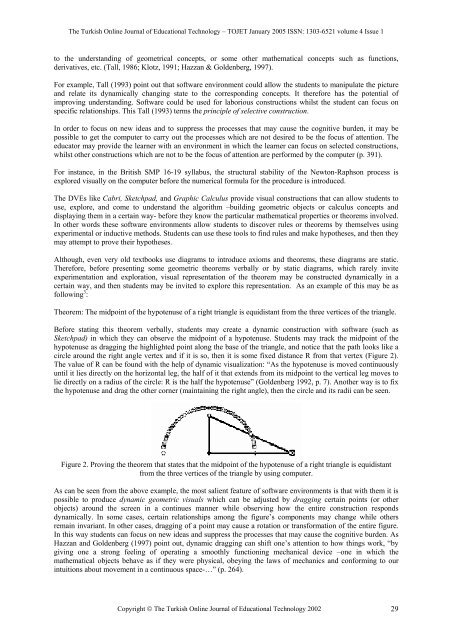Age - TOJET the Turkish online journal of educational technology
Age - TOJET the Turkish online journal of educational technology
Age - TOJET the Turkish online journal of educational technology
You also want an ePaper? Increase the reach of your titles
YUMPU automatically turns print PDFs into web optimized ePapers that Google loves.
The <strong>Turkish</strong> Online Journal <strong>of</strong> Educational Technology – <strong>TOJET</strong> January 2005 ISSN: 1303-6521 volume 4 Issue 1<br />
to <strong>the</strong> understanding <strong>of</strong> geometrical concepts, or some o<strong>the</strong>r ma<strong>the</strong>matical concepts such as functions,<br />
derivatives, etc. (Tall, 1986; Klotz, 1991; Hazzan & Goldenberg, 1997).<br />
For example, Tall (1993) point out that s<strong>of</strong>tware environment could allow <strong>the</strong> students to manipulate <strong>the</strong> picture<br />
and relate its dynamically changing state to <strong>the</strong> corresponding concepts. It <strong>the</strong>refore has <strong>the</strong> potential <strong>of</strong><br />
improving understanding. S<strong>of</strong>tware could be used for laborious constructions whilst <strong>the</strong> student can focus on<br />
specific relationships. This Tall (1993) terms <strong>the</strong> principle <strong>of</strong> selective construction.<br />
In order to focus on new ideas and to suppress <strong>the</strong> processes that may cause <strong>the</strong> cognitive burden, it may be<br />
possible to get <strong>the</strong> computer to carry out <strong>the</strong> processes which are not desired to be <strong>the</strong> focus <strong>of</strong> attention. The<br />
educator may provide <strong>the</strong> learner with an environment in which <strong>the</strong> learner can focus on selected constructions,<br />
whilst o<strong>the</strong>r constructions which are not to be <strong>the</strong> focus <strong>of</strong> attention are performed by <strong>the</strong> computer (p. 391).<br />
For instance, in <strong>the</strong> British SMP 16-19 syllabus, <strong>the</strong> structural stability <strong>of</strong> <strong>the</strong> Newton-Raphson process is<br />
explored visually on <strong>the</strong> computer before <strong>the</strong> numerical formula for <strong>the</strong> procedure is introduced.<br />
The DVEs like Cabri, Sketchpad, and Graphic Calculus provide visual constructions that can allow students to<br />
use, explore, and come to understand <strong>the</strong> algorithm –building geometric objects or calculus concepts and<br />
displaying <strong>the</strong>m in a certain way- before <strong>the</strong>y know <strong>the</strong> particular ma<strong>the</strong>matical properties or <strong>the</strong>orems involved.<br />
In o<strong>the</strong>r words <strong>the</strong>se s<strong>of</strong>tware environments allow students to discover rules or <strong>the</strong>orems by <strong>the</strong>mselves using<br />
experimental or inductive methods. Students can use <strong>the</strong>se tools to find rules and make hypo<strong>the</strong>ses, and <strong>the</strong>n <strong>the</strong>y<br />
may attempt to prove <strong>the</strong>ir hypo<strong>the</strong>ses.<br />
Although, even very old textbooks use diagrams to introduce axioms and <strong>the</strong>orems, <strong>the</strong>se diagrams are static.<br />
Therefore, before presenting some geometric <strong>the</strong>orems verbally or by static diagrams, which rarely invite<br />
experimentation and exploration, visual representation <strong>of</strong> <strong>the</strong> <strong>the</strong>orem may be constructed dynamically in a<br />
certain way, and <strong>the</strong>n students may be invited to explore this representation. As an example <strong>of</strong> this may be as<br />
following 3 :<br />
Theorem: The midpoint <strong>of</strong> <strong>the</strong> hypotenuse <strong>of</strong> a right triangle is equidistant from <strong>the</strong> three vertices <strong>of</strong> <strong>the</strong> triangle.<br />
Before stating this <strong>the</strong>orem verbally, students may create a dynamic construction with s<strong>of</strong>tware (such as<br />
Sketchpad) in which <strong>the</strong>y can observe <strong>the</strong> midpoint <strong>of</strong> a hypotenuse. Students may track <strong>the</strong> midpoint <strong>of</strong> <strong>the</strong><br />
hypotenuse as dragging <strong>the</strong> highlighted point along <strong>the</strong> base <strong>of</strong> <strong>the</strong> triangle, and notice that <strong>the</strong> path looks like a<br />
circle around <strong>the</strong> right angle vertex and if it is so, <strong>the</strong>n it is some fixed distance R from that vertex (Figure 2).<br />
The value <strong>of</strong> R can be found with <strong>the</strong> help <strong>of</strong> dynamic visualization: “As <strong>the</strong> hypotenuse is moved continuously<br />
until it lies directly on <strong>the</strong> horizontal leg, <strong>the</strong> half <strong>of</strong> it that extends from its midpoint to <strong>the</strong> vertical leg moves to<br />
lie directly on a radius <strong>of</strong> <strong>the</strong> circle: R is <strong>the</strong> half <strong>the</strong> hypotenuse” (Goldenberg 1992, p. 7). Ano<strong>the</strong>r way is to fix<br />
<strong>the</strong> hypotenuse and drag <strong>the</strong> o<strong>the</strong>r corner (maintaining <strong>the</strong> right angle), <strong>the</strong>n <strong>the</strong> circle and its radii can be seen.<br />
Figure 2. Proving <strong>the</strong> <strong>the</strong>orem that states that <strong>the</strong> midpoint <strong>of</strong> <strong>the</strong> hypotenuse <strong>of</strong> a right triangle is equidistant<br />
from <strong>the</strong> three vertices <strong>of</strong> <strong>the</strong> triangle by using computer.<br />
As can be seen from <strong>the</strong> above example, <strong>the</strong> most salient feature <strong>of</strong> s<strong>of</strong>tware environments is that with <strong>the</strong>m it is<br />
possible to produce dynamic geometric visuals which can be adjusted by dragging certain points (or o<strong>the</strong>r<br />
objects) around <strong>the</strong> screen in a continues manner while observing how <strong>the</strong> entire construction responds<br />
dynamically. In some cases, certain relationships among <strong>the</strong> figure’s components may change while o<strong>the</strong>rs<br />
remain invariant. In o<strong>the</strong>r cases, dragging <strong>of</strong> a point may cause a rotation or transformation <strong>of</strong> <strong>the</strong> entire figure.<br />
In this way students can focus on new ideas and suppress <strong>the</strong> processes that may cause <strong>the</strong> cognitive burden. As<br />
Hazzan and Goldenberg (1997) point out, dynamic dragging can shift one’s attention to how things work, “by<br />
giving one a strong feeling <strong>of</strong> operating a smoothly functioning mechanical device –one in which <strong>the</strong><br />
ma<strong>the</strong>matical objects behave as if <strong>the</strong>y were physical, obeying <strong>the</strong> laws <strong>of</strong> mechanics and conforming to our<br />
intuitions about movement in a continuous space-…” (p. 264).<br />
Copyright © The <strong>Turkish</strong> Online Journal <strong>of</strong> Educational Technology 2002 29
















